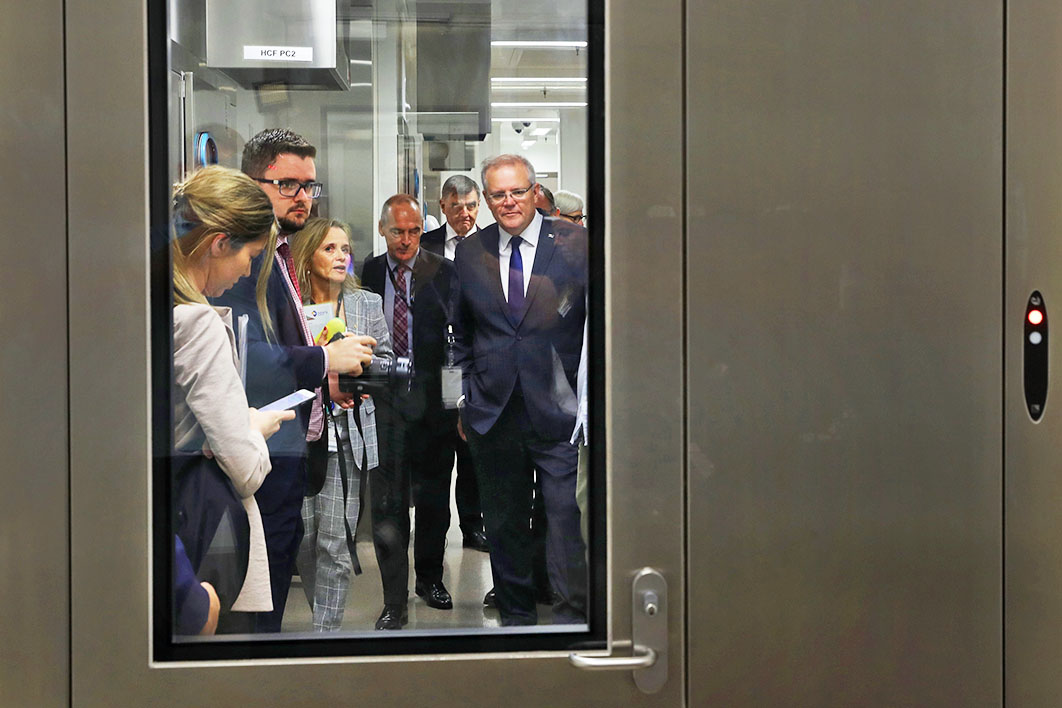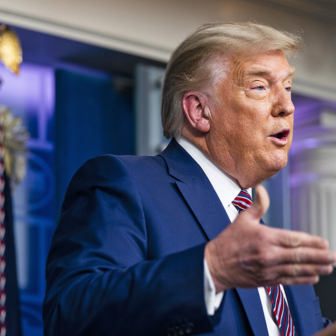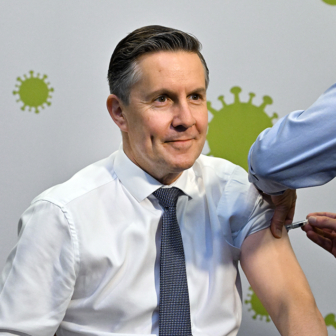When senator Bridget McKenzie moved to the backbench in the aftermath of the sports rorts controversy, the federal government was no doubt hoping that the furore had run its course. But reports suggest that funds from another grants program, the Female Facilities and Water Safety Stream — a scheme intended to support women’s participation in sport across Australia — have been used to build swimming pools in a handful of Coalition-held seats.
The fact that the government was able to misuse these two programs so easily raises questions about other health-related funding decisions.
Health spending ranges from targeted, small-scale grants to multibillion-dollar national programs. Over the past two weeks alone, health minister Greg Hunt has made six significant funding announcements, including $22.3 million for “new treatments and breakthrough cures,” $5.5 million for ten new medical research projects, $32 million for partnerships between industry and researchers, an unspecified amount for additions to the list of subsidised pharmaceuticals, and the provision of free glucose monitoring devices for 21,000 people with diabetes (as part of a broader $300 million program). Two weeks earlier the prime minister had announced $76 million in new funding to support the mental health needs of people affected by the bushfires, including grants targeting affected communities.
Given what we know about the sports rorts controversy, can we be confident that these decisions were made without reference to political advantage? After all, Senator McKenzie is not the first politician to be accused of pork-barrelling: previous federal governments have come under scrutiny for issuing additional MRI licences in marginal electorates, for example, or, more famously, promising funds to keep Tasmania’s Mersey Hospital open despite expert advice to the contrary.
Funding decisions targeted at marginal seats are easy to spot. But politics has triumphed over policy in many other cases, including in some of the largest healthcare programs. They go unnoticed partly because of the size and complexity of the programs, which makes it difficult to identify when and why crucial decisions are made. But the lack of recognition also shows how the disproportionate influence of interest groups is seen as a routine component of policy development rather than an intentional strategy to advance certain interests over those of Australian consumers.
Take, for example, one of Australia’s biggest health programs, the Pharmaceutical Benefits Scheme, or PBS. Considering the scheme represents around 15 per cent of the health budget, or just under $13 billion in 2019–20, it’s reassuring to know that decisions about which medicines to subsidise are based on expert advice from the Pharmaceutical Benefits Advisory Committee, or PBAC, and subcommittees made up of clinicians, health economists, consumers and other stakeholders.
There’s a problem, though. The committee might be independent, but it is purely advisory. Final decisions are made by the health minister or (if the medicine is likely to cost more than $20 million a year) federal cabinet.
This discretion provides a window of opportunity for companies and professional groups that want to influence listing and pricing decisions. It’s hard to say how often they succeed, but we do know that (at the very least) pharmaceutical companies invest substantial resources in attempting to influence PBS decisions, in many cases funding consumer organisations and “experts” to advocate on their behalf. The evidence that drug prices on the PBS are higher overall than in comparable countries suggests that this investment might be paying off.
Can the politicisation of the PBS be reduced? Lobbying in general, including by pharmaceutical companies, could be made more transparent by applying the same standards to all people seeking to influence government, whether they are “in house” (which currently exempts them from the lobbying register) or external. The drug testing that companies plan to use in applications for PBS listing could be pre-registered to strengthen the evidence base for decisions. More effective procurement mechanisms for medicines — competitive tendering, for example, as in New Zealand — could be adopted. And local prices could be benchmarked against international prices.
Each of these safeguards has already been proposed without success. Increasing the transparency and objectivity of the PBS process can be difficult when both government and the pharmaceutical sector benefit from its politicisation — pharmaceutical companies because they can use their influence to have their products listed or their prices raised, governments because listing new medicines provides a steady stream of positive media opportunities.
Medicare is another major area of health spending (around $23 billion in 2018–19) in which the evidence suggests political interests influence funding decisions. The implementation of recommendations of the MBS Review Taskforce is a good example. The taskforce was established after health economist Adam Elshaug and his colleagues identified more than 150 potentially low-value procedures on the Medicare Benefits Schedule, or MBS. Among them were knee arthroscopies and spinal fusions (in specific circumstances) that carried significant risks for patients and were backed by little or no evidence.
Of the almost 6000 items on the MBS, Elshaug found, only around 3 per cent had been formally assessed against contemporary evidence of safety, effectiveness and cost-effectiveness. Many of these items were listed some time ago and, until recently, there had been no systematic process for updating listings in line with new research and changes in clinical practice.
Despite the fact that the taskforce’s seventy committees have made extensive recommendations in sixty-seven reports since work began in 2015, the number of low-value procedures on the schedule has not fallen significantly.
Not surprisingly, medical groups have lobbied hard. Anaesthetists, for example, objected to changes that would have reduced rebates for their services in line with evidence that the current arrangements don’t represent good value. GPs objected when one of the review committees recommended more Medicare funding for nurse practitioner services. Clinical psychologists objected to a proposal to remove the differential rebates between services provided by clinical and non-clinical psychologists.
The government has been reluctant to risk political damage from conflict with the medical profession, particularly since the health minister has worked hard to re-establish the Coalition’s credibility in his portfolio after Labor’s 2016 “Mediscare” campaign and public relations mistakes by previous ministers.
Medical groups know that the Coalition can’t afford a public battle, and they have used this fact to their advantage by lobbying against changes that might reduce the earning potential of some of their members. As a result, much low-value care continues to be funded through Medicare and consumers continue to receive treatment that exposes them to risk but delivers little or no benefit.
As is the case with PBS listings, identifying the exact processes of influence is difficult. Given the fate of many of the MBS Review Taskforce’s recommendations, though, it appears that interest groups have been successful in persuading the government to let political considerations override the benefits of making evidence-based changes.
One of the most politicised areas of health funding is the private health insurance rebate, a scheme that costs taxpayers around $6 billion in direct subsidies and a further $6 billion mainly in revenue lost via tax breaks for higher earners. This adds up to around 120 times the funding that went into the controversial Community Sports Infrastructure Program grants and yet, despite frequent calls for a review, the scheme has never been evaluated against its aims.
The private insurance rebate is an example of how an ostensibly universal program can have a different impact on different communities, depending on their political colour. Because membership of private funds varies significantly across regions, the allocation of funding under this scheme differs according to a community’s political affiliation.
Put simply, Coalition voters are much more likely to take out private health insurance than people who support Labor or the Greens. In fact, the market research company Roy Morgan found in 2016 that twenty-one out of the twenty-five electorates with the highest level of private health insurance membership were Coalition-held.
Four years on, this situation has barely changed — although two of the Coalition seats have changed hands, one to an independent (Warringah) and one to Labor (Hindmarsh). Even so, the ten electorates with the highest level of private health insurance membership are all still Coalition seats and, overall, three-quarters of the top twenty-five electorates are represented by Coalition MPs.
This means that the private health rebate goes disproportionately to areas represented by Coalition members. While all taxpayers contribute to the subsidies via their taxes, areas with a greater proportion of Coalition voters receive significantly more benefits. Without any overt political agenda, the rebate can therefore be a highly effective way of directing public funding into areas with a specific political allegiance.
A much more equitable use of this funding would be to redirect the $12 billion towards services — public hospitals, public dental services and allied health services — that benefit the whole community. This would also be a much more efficient use of resources.
Yet another big spending area within the health portfolio is the Community Pharmacy Agreement, or CPA, a deal between the federal government and the Pharmacy Guild that sets remuneration levels for the dispensing of medicines and funds home medicine reviews and other pharmacy-related programs. The current PGA, the sixth, includes around $19 billion of funding over five years; the next one (currently being developed) is reported to include around $25 billion.
The potential for improper influence in the CPA largely comes from the lack of transparency in its development and execution. Negotiations involve only limited input from consumers, other peak pharmacy groups and other key stakeholders, obscuring whether the agreement’s remuneration levels represent good value for the Australian community and whether all the conditions outlined in the agreement have been met.
The Australian National Audit Office shares these concerns. In its report on the administration of the Fifth Community Pharmacy Agreement, it found that
shortcomings in Health’s performance reporting and 5CPA [Fifth Community Pharmacy Agreement] evaluation framework mean that the department is not well positioned to assess whether the Commonwealth is receiving value for money from the agreement overall, or performance against its six principles and objectives…
and
there is no ready basis for the Parliament or other stakeholders to determine the actual cost of pharmacy remuneration delivered under the 5CPA.
In this environment, the Pharmacy Guild can promote its own interests at the expense of the community. Extensive evidence suggests this has occurred over a series of CPAs, resulting in anti-competitive practices, higher prices and reduced access for consumers.
Unlike in the case of the sports rorts affair, though, the findings of the auditor-general (and other similar reviews and inquiries) have resulted in very little negative publicity for the responsible minister or the government. In fact, Greg Hunt is currently negotiating a seventh CPA with the Pharmacy Guild that will lock in another multibillion-dollar agreement for the next five years.
Of course, interest groups can only exert power over governments to the extent that governments allow themselves to be influenced. A crucial enabling factor in all of these examples is the willingness of governments of all persuasions to trade off good policy outcomes for short-term political gains, even when independent, evidence-based processes are in place (the PBS), or the evidence suggests that funding mechanisms and processes serve the interests of specific groups at the expense of the general community (the PGA).
The problem could be at least partly solved by reducing the government’s role in health funding decisions, while still allowing it to set broad policy directions and respond to emerging health threats. This could be done in a number of ways.
First, a new independent body could take on many of the decisions currently made by government. Labor’s pre-election proposal for an independent body to administer health funding is worth considering, although it would need to be given final responsibility for at least some health funding decisions and not just function in an advisory capacity.
Second, mechanisms for giving consumers input into health resource allocation decisions should be used throughout the health system. A number of existing models, such as citizens’ juries, have been used successfully in Australia for this purpose. They can tackle inequities in our current system by bringing in groups usually under-represented in health decision-making, including Aboriginal and Torres Strait Islanders, people with chronic and complex conditions, people with lived experience of mental illness and people from rural areas.
Third, Primary Healthcare Networks, Aboriginal Medical Centres and other community-based health organisations could be given a greater role in resource allocation. These organisations have transparent governance processes and consumer/community representation, and are far removed from the day-to-day pressures of federal politics. They also know their communities’ needs far better than ministers and bureaucrats in Canberra. Both Britain and New Zealand have decentralised significant components of health funding and offer important lessons for Australia.
Any of these options would help depoliticise the health system and reduce the influence of a small number of interest groups. They could also tackle the perennial underfunding of preventive health measures and take account of the social determinants of health and the health impacts of climate change.
Even with these changes, though, governments could continue to make health policy and funding decisions that deliver political benefits at the expense of the wider community. Given that both sides of politics have a vested interest in maintaining the status quo, supporting free and independent reporting on healthcare decision-making should also be a high priority. •




